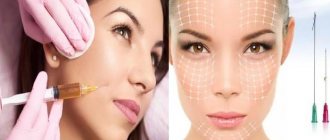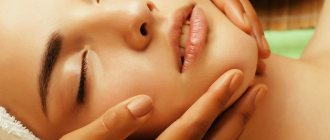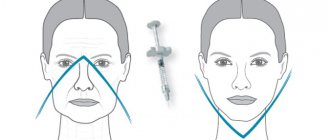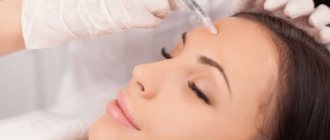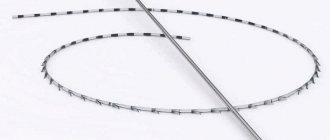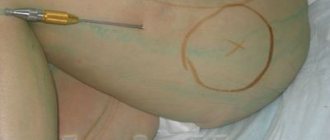The introduction of fillers or contouring is one of the most common procedures in modern cosmetology. Thanks to their dense and viscous structure, the injected gels fill subcutaneous voids and depressions, eliminating the most unpleasant problem of all women - wrinkles, and also allow you to emphasize the necessary area: give a more pronounced shape to the cheekbones or highlight the lips.
Currently, there are many filler drugs, but, unfortunately, each of them has a number of indications and contraindications, advantages and disadvantages.
In cosmetology practice, biodegradable preparations are used, which contain substances that are biocompatible with human tissue, are not recognized by the immune system and are slowly eliminated from the body.
Fillers - what are they?
Fillers are filler drugs that are injected under the skin to correct cosmetic imperfections on the face and body. They are mainly used to smooth out wrinkles and add volume to the lips, cheekbones, and chin.
Fillers have been used in cosmetology for half a century. Such “beauty injections” appeared much earlier than Botox. At first, the filler was silicone or paraffin, which forever settled under the skin on the face and even wandered there as it pleased.
But cosmetology is “progressing”. Now the fillers are different. They ALLEGEDLY do not cause complications or allergic reactions, spread evenly and do not spread anywhere, have a high level of predictability of results... Drug manufacturers and cosmetologists make many loud statements.
Our article is based on an analysis of scientific research and patient reviews. She dispels most myths. But first things first.
In what cases is it prohibited to enter?
There are many contraindications for the injection of fillers that need to be taken into account. The procedure cannot be performed if:
- There is an active skin infection (warts, herpes, mites, lichen, etc.).
In this case, additional trauma to the skin can lead to undesirable consequences - the addition of a third-party infection. In addition, it is worth remembering that filler is a foreign body that the body is trying to remove, and if you administer the drug during an exacerbation of the infection, you can get a purulent abscess on the face. If the patient exhibits signs of HSV in the acute stage, then the procedure cannot be performed - preventive treatment is prescribed. If this is not done, the virus may reactivate and quickly spread throughout the skin. In addition, if the patient has the herpes virus in her body, then preventive treatment should be prescribed before using the filler. - ENT infections (Infections of the nasopharynx, ear canal, alveolar abscess, periodontitis).
Dermal fillers, once injected, can lead to an exacerbation of many diseases. There is a lot of evidence that makes it clear that ENT infections, especially in the acute stage, are able to penetrate into the area of drug administration and contribute to the formation of biofilms. - Gastroenteritis, bladder infection, pyelonephritis . If the patient’s medical history revealed one or more similar diseases, then she is sent for a consultation with a specialist - if chronic diseases are not in the acute stage, then the cosmetologist solves this issue independently and individually, evaluating the pros and cons.
Allergy . Can you be allergic to fillers? If there are allergic reactions, it is worth considering a group of drugs and products to which the patient’s body reacts especially acutely. And if there is no intolerance to the components of the filler, then preventive treatment is prescribed, after which the drug is administered.- Hypersensitivity to components . In this situation, the use of filler is strictly contraindicated, since the consequences can be irreversible - chronic urticaria, immunodeficiency state, Quincke's edema. But besides this, a drug injected under the skin can behave unpredictably.
- Tuberculosis . If a person is sick with tuberculosis or has Wegener's granulomatosis, then the doctor determines the possibility of contouring plastic surgery individually. Often the patient is sent for consultation to a specialist who assesses possible risks. Only after this is the final decision made.
Other problems
It is worth noting that if the patient’s diabetes was discovered no more than 2 years ago, then contour plastic surgery can be performed after an examination. The procedure is prescribed according to the doctor's decision. Why do you need to consult a doctor?
- Skin inflammation (dermatitis) . If you have skin diseases, you should first visit a dermatologist, who will decide how safe the procedure will be for the patient. But it is worth remembering that the risk of purulent inflammation in this situation increases significantly.
- Systemic viral infections .
In this case, contouring measures can be carried out, but only during the period of remission. It is worth understanding that each disease has a different remission. In this case, consultation with a specialist is necessary, since remission is usually followed by exacerbation of diseases. - Autoimmune diseases. At this stage, there is no data on the impact of these diseases on the procedure for facial contouring, and it is unknown how the filler behaves.
Therefore, after visiting a doctor and a detailed consultation, the procedure can be performed, provided that the patient’s wounds heal without complications. - Crohn's disease, ulcerative colitis . For these diseases, before going for a contouring procedure, you need to consult your doctor. If there are no contraindications at the moment, then fillers are injected.
- Other problems . Any chronic diseases during the period of complications become a contraindication to the use of fillers, since there is a high probability of infection entering the bloodstream at the injection site.
We invite you to watch a video about contraindications for the procedure:
Indications for injection of fillers
Fillers are injected into a variety of areas: face, neck, décolleté, hands. Dermal fillers are used for:
- combating age-related skin changes: wrinkles, nasolabial folds, nasolacrimal grooves, drooping corners of the lips, ptosis (drooping) of the oval of the face, etc.
- correction of the size and shape of the chin, nose, cheekbones, lips,
- correction of facial asymmetry,
- getting rid of scars, scars, acne marks,
- reinforcement (support) of soft tissues of the neck, décolleté, and arms.
Facial fillers
Let's see what cosmetologists say about the effect of fillers. “Fill voids”, “fill sunken and sagging places on the face”, “restore collagen fibers”, “improve cell synthesis and stimulate the production of collagen and elastin”, “fix in the tissues, becoming overgrown with collagen, and do not move anywhere”, “improve the quality skin”, “moisturize the skin”...
Now let's talk about how dermal filler actually works.
- Fills voids and thereby smooths out wrinkles and fills sagging tissues?
These are not such empty spaces. These are fabrics that are actually pushed apart and stretched by the filler. And this is harmful for them. The real “emptiness” will appear when the filler dissolves. And they will begin to sink into the upper layers of the dermis even more actively than it was before the injections. After the drug wears off, wrinkles, creases and folds will become much deeper and more noticeable. - Replenishes volumes?
Volume indeed appears, but this is not replenishment, but an artificially created load on the tissue. And first of all, the muscles and ligaments suffer, which are forced to carry the burden in the form of a gel. What will happen in the end? The face will rush downward because spasmed muscles and stretched ligaments will not be able to hold the tissue. - Moisturizes and improves skin quality?
It is stated that hyaluronic acid attracts and accumulates water molecules and thereby fights dehydration. But such an impression can only be formed in the first time after the procedure. Very soon, due to forced, artificial hyperhydration, the dermis will dry out. Why? Because self-regulation mechanisms work in our body. If an unusual, shock dose of hyaluronic acid is suddenly introduced into it, it will begin to intensively produce an enzyme that destroys it. And what will this enzyme do? That's right, destroy a person's own hyaluronic acid. In addition, the body will stop producing it in the same volumes. Why work if it is given for free?
And now imagine what the “victim” of contouring will be left with in about a year, when the effect of the drug wears off. She will look at herself in the mirror with horror. The problems will only get worse, the skin will become dry, wrinkled, stretched, and flabby.
What to do? Run to a cosmetologist for a new portion of illusory youth. And this will happen again and again. So they get hooked on the needle of “beauty injections”.
Recommendations for skin care after the procedure
Recommendations after the contouring procedure, namely the introduction of fillers:
- It is strictly forbidden to stay in the sun for a long time, and you should also avoid visiting the solarium.
- You should not sleep on your face at night, and you should not take a horizontal position for 4-6 hours after the procedure.
- Avoid visiting saunas and steam baths.
- In the first few days you should not use decorative cosmetics.
- Limit active facial expressions for several days. Also, during the first day, try not to touch your face with your hands.
- You cannot use aggressive means such as home peeling for 2 weeks.
- You should also give up alcohol and hot drinks for the first week (read more about drinking alcohol before and after the procedure here).
- Do not wash your face with soap, using only soft foam cleansers.
- A cosmetologist recommends facial skin care products after contouring.
You can usually use professional creams designed specifically for the skin after the introduction of hyaluronic fillers. - If bruises and hematomas appear as a result of the administration of the drug, you can use special medications aimed at eliminating these defects, but only those recommended by the cosmetologist.
- Immediately after the procedure, you need to drink a lot of clean water so that the filler spreads faster inside the muscles.
You can switch to your usual cosmetics within a month.
We invite you to watch a video on how to care for your skin after the filler procedure:
To learn more about fillers, we suggest reading the following articles:
- Kinds.
- Rules of application.
- What is better - biorevitalization or filler?
- Comparison of fillers with different anti-aging procedures.
Types of fillers by composition
- Synthetic.
It all started with them back in the 1970s. They were made from silicone and paraffin. This is the toughest option. Such fillers are not eliminated from the body on their own, they wander around the face and distort its features, and are a powerful allergen. Due to their low cost, they are still used, but rarely. - Biosynthetic.
Consist of artificial and natural components. Due to the addition of substances “related to human skin,” they should be better absorbed and distributed more evenly. But the drug still migrates, causing complications and allergic reactions. The effect is no longer lifelong, but up to 3-10 years. - Biodegradable: based on hyaluronic acid, collagen, calcium hydroxyapatite, polylactic acid.
This is the latest generation of fillers, which is considered the most progressive. They are used most often.
The propaganda of biodegradable fillers is based on the claim that they consist of biodegradable components, which are also supposedly friendly to our skin. This filler does not last long compared to its predecessors. Its professed advantages are the absence of allergic reactions, even distribution, and a minimum of side effects.
But all this is NOT TRUE!
To prove this, let's look at filler based on hyaluronic acid. This is a favorite among cosmetologists and has surpassed everyone else in popularity. Hit.
Hyaluronic filler
Myth
: fillers based on hyaluronic acid are distributed evenly and accurately to the target, do not cause complications, are hypoallergenic, and safe for health. The filler is removed from the body as soon as its effect ends, that is, after six months to a year.
In fact
, fillers based on hyaluronic acid:
- Unevenly distributed.
After injections, lips often become uneven and asymmetrical. The patient is asked to come for correction in two weeks. Granulomas (dense fibrous nodules) and scars may form. - Have high diffusion
, that is, the ability to spread beyond the “target”. Filler often migrates from the target area to neighboring areas, which looks unsightly and cartoonish.For example, with lip augmentation, a common effect is “hyaluronic mustache.” This is when hyaluronic acid “leaks” into the tick above the upper lip. The drug can go higher and also cause swelling. Have you seen girls with a “proboscis” instead of an upper lip? This filler “climbed” to the top.
Or chin. With him, the opposite happens: the drug creeps down onto the neck - naturally shifts from the facially active zone towards the direction of least resistance. And instead of an expressive contour, the patient receives excess volume in the area under the lower jaw and neck, and a double chin appears.
- They cause side effects everywhere and are often accompanied by complications.
The integrity of the skin is compromised, so the body will certainly react to both mechanical damage and a foreign agent. There are inevitable reactions that occur in everyone, and there are complications that require medical and surgical intervention.- Terrible swelling and hematomas are widespread. Cosmetologists warn about them as possible side effects that will go away in a few days, but the problem can last for months.
- Nodules, granulomas, and fibrosis (tissue scarring) often form. The bumps can stick out very clearly and even bother you.
- The area affected by injections may become inflamed, covered with ulcers, and attract infection or herpes.
- Sometimes the color of the skin changes, it turns blue, this action is called the Tyndall effect. If the substance is not injected deeply enough, it may swell, showing through the skin.
- In some cases, tissues die (necrosis) and vascular occlusion (obstruction) occurs.
- Several cases of blindness and nerve palsy have been reported.
- Cause allergies.
Patients are often not warned about this. On the contrary, hyaluronic acid filler is most often touted as hypoallergenic. But there are entire scientific studies on this subject. In particular, Dr. Tahera Bhojani-Lynch urges cosmetologists to be sure to inform patients about the possibility of complications.Allergic reactions occur a few minutes or hours after the injection of the filler (Quincke's edema, anaphylaxis) or develop after 2-3 days (induration, intense redness, swelling) and last for months.
Moreover, an inflammatory response to filler may occur after 3 months or later. Such a late-onset allergic reaction can occur both after the first procedure and after the second. The entire affected area will turn into compacted inflammation and may become covered with persistent nodules.
- They remain inside the patient’s body for many years.
- Harmful to health in the long term.
Fillers based on hyaluronic acid contain the genetic material of streptococcal bacteria, from which the active substance is synthesized. And after injection, this material settles in the body for many years. Microorganisms can become active soon after the procedure, or after 5 or 10 years. And they can cause characteristic diseases: pharyngitis, laryngitis, sore throat, otitis media, pneumonia, rheumatism, etc.In addition, the filler contains “crosslinks” - chemical agents that are added to give the active substance a gel-like consistency. Such stabilizers are organic poisons. Their presence in the drug is justified by small doses, but they are still toxins. Scientists are wary of them because their health hazards have not been studied.
The best biosynthetic fillers
Elance
Ellance is a biosynthetic composition, the main component of which is polycaprolactone. Some series are produced on the basis of hyaluronic and polylactic acids. The filler is biodegradable and is maximally compatible with the human body. The risk of rejection of the injected filler or an allergic reaction to it is minimized. The filler is produced in the Netherlands and has been used for several decades in both surgery and cosmetology.
Ellance is a universal drug; it can be used to correct age-related changes (after 30 years), as well as to correct defects in the shape of individual zones or facial symmetry. Gives a visible positive result in eliminating facial wrinkles, nasolabial folds, correcting scars and cicatrices, increasing the volume of lips, cheekbones, correcting asymmetry, and the shape of the nose.
Ellance has several release options, which are designated by the letters of the Latin alphabet S, M, L and E. They have no differences in composition, the only way they differ is in the duration of the effect from a year for S to 4 years for E.
Release form: 2 syringes, 1 ml each.
Cost from 18,000 to 44,000 rubles.
Elance
Advantages:
- long-lasting action;
- the effect is visible immediately;
- universal;
- the ability to choose the duration of validity (from 1 to 4 years);
- administration of the drug activates collagen production;
- can be combined with other cosmetic procedures;
- suitable for people intolerant to hyaluronic acid;
- used to correct aesthetic imperfections of the face.
Flaws:
- administration of the drug requires a highly qualified specialist, otherwise side effects are guaranteed;
- Expensive.
Sculptra
Sculptra (or New Fill) is a French drug for skin rejuvenation based on polylactic acid. Sculptra not only functions as a filler, but also promotes the production of your own collagen. Being a synthetic filler, Sculptra does not cause a negative reaction from the immune system, and it dissolves on its own after the period of action has expired. The drug was originally developed for medical purposes, which increases confidence in its quality.
Sculptra is used in the following cases: smoothing wrinkles of varying depths, correcting the shape of the nose, chin, and facial contours, replenishing the lack of tissue volume in various areas (lips, cheekbones, cheeks), camouflaging scars. All of the above actions are carried out only with patients over 35 years of age.
Release form: 1 or 2 bottles of the product in dry form. The concentrate is diluted with saline several hours before use. One bottle of dry substance produces 5 ml of a ready-to-use drug.
Cost from 16,000 rubles. (1 bottle).
Sculptra filler
Advantages:
- the use of Sculptra gives both immediate and prolonged effects due to the production of one’s own collagen;
- ideal for older patients;
- effective in cases of correcting acquired defects in appearance - replenishing the volume of facial tissues;
- can be used both on the face and on the rest of the body;
- the drug is eliminated from the body independently, naturally;
- The drug is valid for more than 2 years.
Flaws:
- cannot be used to smooth out fine wrinkles;
- The set does not include an injection syringe, you need to purchase it separately;
- cannot be used simultaneously with other fillers;
- inconvenient packaging (5 ml is too much for use in any one area);
- side effects in the form of redness, swelling, and in more complex cases - thickening, especially under the eyes.
Radiesse
Radiesse is a biosynthetic drug based on calcium hydroxyapatite, which is not alien to the human body and is biocompatible. The main active drug is of artificial origin, which reduces the likelihood of allergies. Radiesse was developed for the restoration of facial tissues; now it is successfully used not only in cosmetology, but also in dentistry and surgery.
In cosmetology, the drug is used to smooth out nasolabial folds, improve the shape of the cheeks, chin, cheekbones, tighten the temporal region, décolleté, correct the oval of the face, eliminate scars. All of the listed manipulations using Radiesse are indicated for patients over 35 years of age.
Release form - syringes with a volume of 0.8, 1.5, 3 ml, containing 30% of the active substance and 70% of a gel carrier based on distilled water.
Cost: from 8000 rub.
Radiesse
Advantages:
- the effect of the drug is noticeable immediately after injection;
- after 2 weeks it starts collagen production;
- the duration of the drug is from one and a half to two years;
- ideal for correcting the shape of the cheekbones;
- does not cause allergic reactions.
Flaws:
- It is not advisable to use in people with thin and sensitive skin;
- not suitable for lip augmentation, smoothing wrinkles under the eyes and correcting the shape of the nose;
- does not apply until age 35;
- if administered incorrectly, it forms lumps and tubercles;
- Negative consequences of unprofessional administration of the drug are visible over a long period.
Features of using fillers
Fillers are administered by injection into the deep layers of the skin. The procedure is very painful. Neither local anesthesia nor lidocaine in some medications helps. And you have to endure it for a long time. The target area is pricked repeatedly. On average, it takes 30-40 minutes to process one area.
Depending on the area of the face, it is recommended to use fillers with different consistencies. For example, a less dense filler is injected into the lips and under the eyes, and a denser one into the chin.
It is impossible to accurately predict the result. The drug often stands up unevenly, the patient is invited to undergo correction in a couple of weeks.
It is believed that the filler is absorbed after 2-3 weeks. The effect lasts 6-12 months (for biodegradable fillers).
If the patient is not satisfied with the result, she may be advised to knead the areas vigorously, until it hurts. Is it dangerous. What if the filler injection site is swollen not due to swelling, but due to an inflammatory reaction? Such areas cannot be massaged. This may cause symptoms to worsen.
At what age can fillers be used?
It all depends on the zone. If, for example, a person has an unpronounced hump on his nose that he doesn’t like, he can correct it with filler even at 18! What's the point of waiting and collecting complexes when the problem is solved with 0.1-0.2 ml of the drug? In this area, tissue changes are only to our advantage: after several professional corrections, we will achieve a result that will last for a long time.
It's the same story with the chin. When a person has an insufficiently pronounced or slanted jaw, there are several options for solving the problem: orthodontics, surgical advancement of the lower jaw with a long rehabilitation period, or correction with filler. In this zone you don’t have to worry about swelling – maintain the results for at least 20 years without fear of consequences.
The story with lips is more complicated. With repeated corrections and failure to comply with the decay time of the filler from the previous injection, we can get a change in blood circulation with the formation of stagnation - edema.
Follow the time limits and be careful! I am not against the introduction of gel if a person has asymmetry, disproportion or a pronounced defect - everyone wants to be beautiful here and now. “Let’s do it because it’s fashionable” is not my story.
Lip fillers
Lip augmentation is the most common option for using fillers. Lips are a very delicate and sensitive organ, so the procedure is especially painful and dangerous.
In most cases, the appearance of the lips deteriorates after augmentation. They lose their shape and turn out like a duck. The proportions of the face are disrupted, and as we know, beauty is not when there is too much of one thing, but when all parts of the whole are in harmony with each other.
After injections, lips swell everywhere, become covered with hematomas, and become uneven and asymmetrical. Bumps form inside. Herpes may appear. Sensitivity is lost. The area above the upper lip swells due to migration of the drug.
Fillers under the eyes
Fillers under the eyes are recommended for those who suffer from dark circles, bags, wrinkles, and depression in the nasolacrimal trough.
Under-eye fillers are an even riskier procedure than lip injections. The treated area is located next to a very delicate organ and has the thinnest skin. The consequences may be irreparable. Occlusion (obstruction) of the vessels of the ophthalmic artery may occur. There are cases where such a complication after fillers led to blindness.
Contraindications and side effects
Cosmetologists warn that the seemingly safe filler is a medical substance, which means it should be used with caution. There are a number of contraindications in which the drug is more likely to cause harm than benefit:
- inflammation of the skin at the injection site;
- pregnancy and breastfeeding;
- polyvalent allergy;
- exacerbation of chronic diseases.
It is not advisable to perform facial filleting during menstruation and drink alcohol before or after the procedure. The consequences can be the most unpredictable, including hemorrhages and local inflammation.
Failure to comply with the administration technique or low qualifications of the cosmetologist often lead to adverse reactions.
Most often noted:
- redness of the face at the injection site;
- soreness;
- rosacea;
- hematomas;
- nodules, peas under the skin.
If the product is not injected deeply enough, itching and irritation may occur, and bubbles filled with clear liquid form on the surface of the dermis.
Never do filleting on your own or with a friend. The procedure requires special training and practical skills. If the technology and asepsis rules are violated, such an experiment can result in serious complications, including infection and tissue necrosis.
Why are facial fillers dangerous?
The aggregates themselves are not considered harmful. The danger lies in the wrong choice of drug or unsuccessful administration.
The most serious consequence of facial filleting is a deterioration in venous or arterial blood flow or complete blockage of blood vessels. The pathology is accompanied by ischemia and cell death, and deterioration of vision.
After treatment, numerous scars and scars remain on the face - traces of necrosis. Moreover, visual impairment can become permanent and lead to blindness.
Fortunately, such complications are rare, and if the injection technology is followed, they are completely eliminated.
Safe and effective alternative to fillers
You have to pay dearly for such instant “transformations” on the cosmetologist’s couch. We are, of course, not about money (although filler injections are ruinous). We are about beauty, youth, health.
To prevent your skin from prematurely becoming dry, sagging and wrinkled, don’t rely on the “magic” of fillers. It is built on illusion. A trick that will age you and deprive you of your beauty.
Isn’t it better to deal with your face systematically and constantly, in conjunction with the rest of the body? Spend 10-15 minutes a day on self-massage of the face and gymnastics? This is the only way to preserve youth and even turn back time.
MelAnnett's big broadcast, in which she talks and shows exercises for the beauty and youth of the face:
Our updated basic marathon “SmeloNET” is designed to straighten your back and rejuvenate your face. Read more about him further.

